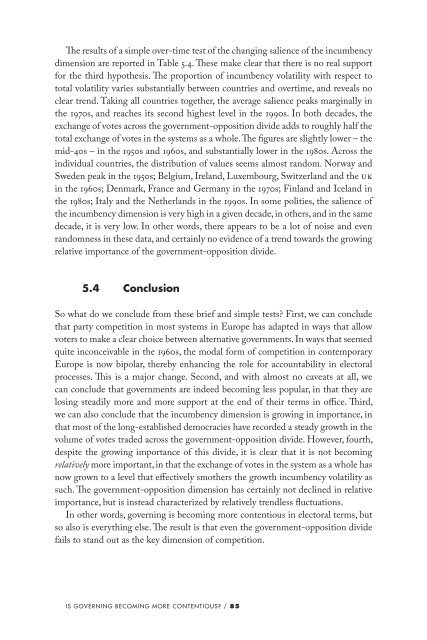download - UvA DARE
download - UvA DARE
download - UvA DARE
You also want an ePaper? Increase the reach of your titles
YUMPU automatically turns print PDFs into web optimized ePapers that Google loves.
The results of a simple over-time test of the changing salience of the incumbency<br />
dimension are reported in Table 5.4. These make clear that there is no real support<br />
for the third hypothesis. The proportion of incumbency volatility with respect to<br />
total volatility varies substantially between countries and overtime, and reveals no<br />
clear trend. Taking all countries together, the average salience peaks marginally in<br />
the 1970s, and reaches its second highest level in the 1990s. In both decades, the<br />
exchange of votes across the government-opposition divide adds to roughly half the<br />
total exchange of votes in the systems as a whole. The figures are slightly lower – the<br />
mid-40s – in the 1950s and 1960s, and substantially lower in the 1980s. Across the<br />
individual countries, the distribution of values seems almost random. Norway and<br />
Sweden peak in the 1950s; Belgium, Ireland, Luxembourg, Switzerland and the UK<br />
in the 1960s; Denmark, France and Germany in the 1970s; Finland and Iceland in<br />
the 1980s; Italy and the Netherlands in the 1990s. In some polities, the salience of<br />
the incumbency dimension is very high in a given decade, in others, and in the same<br />
decade, it is very low. In other words, there appears to be a lot of noise and even<br />
randomness in these data, and certainly no evidence of a trend towards the growing<br />
relative importance of the government-opposition divide.<br />
5.4 Conclusion<br />
So what do we conclude from these brief and simple tests? First, we can conclude<br />
that party competition in most systems in Europe has adapted in ways that allow<br />
voters to make a clear choice between alternative governments. In ways that seemed<br />
quite inconceivable in the 1960s, the modal form of competition in contemporary<br />
Europe is now bipolar, thereby enhancing the role for accountability in electoral<br />
processes. This is a major change. Second, and with almost no caveats at all, we<br />
can conclude that governments are indeed becoming less popular, in that they are<br />
losing steadily more and more support at the end of their terms in office. Third,<br />
we can also conclude that the incumbency dimension is growing in importance, in<br />
that most of the long-established democracies have recorded a steady growth in the<br />
volume of votes traded across the government-opposition divide. However, fourth,<br />
despite the growing importance of this divide, it is clear that it is not becoming<br />
relatively more important, in that the exchange of votes in the system as a whole has<br />
now grown to a level that effectively smothers the growth incumbency volatility as<br />
such. The government-opposition dimension has certainly not declined in relative<br />
importance, but is instead characterized by relatively trendless fluctuations.<br />
In other words, governing is becoming more contentious in electoral terms, but<br />
so also is everything else. The result is that even the government-opposition divide<br />
fails to stand out as the key dimension of competition.<br />
Is governIng becomIng more contentIous? / 85
















